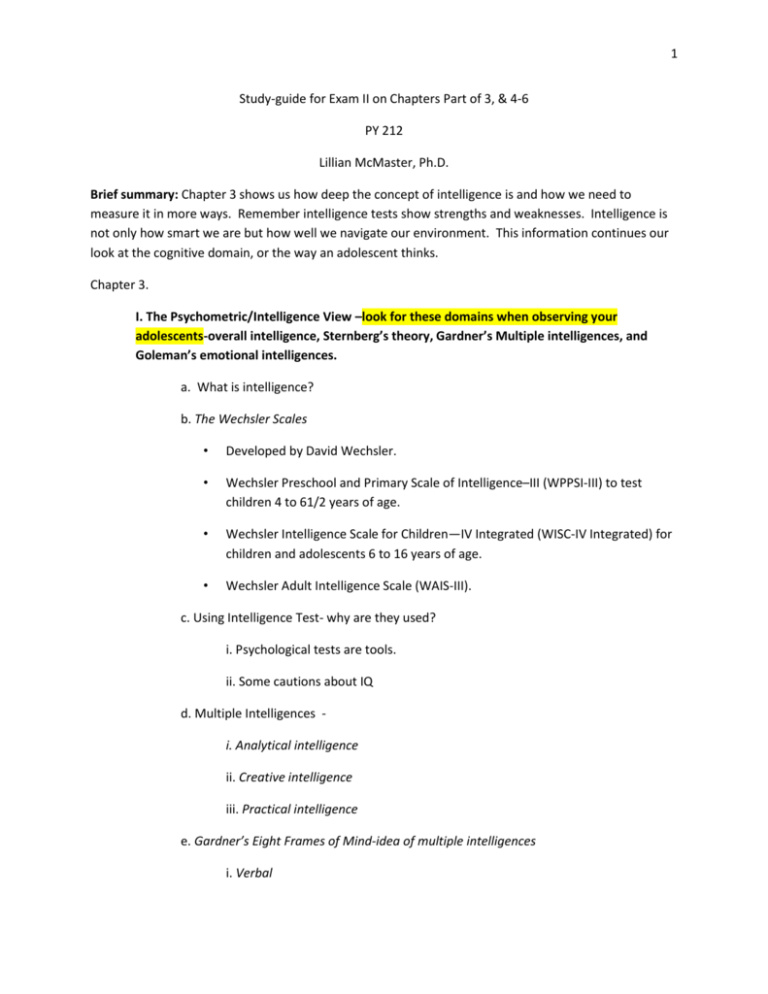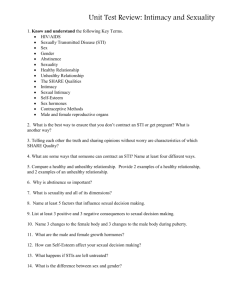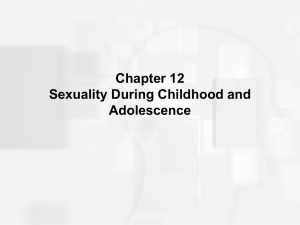
1
Study-guide for Exam II on Chapters Part of 3, & 4-6
PY 212
Lillian McMaster, Ph.D.
Brief summary: Chapter 3 shows us how deep the concept of intelligence is and how we need to
measure it in more ways. Remember intelligence tests show strengths and weaknesses. Intelligence is
not only how smart we are but how well we navigate our environment. This information continues our
look at the cognitive domain, or the way an adolescent thinks.
Chapter 3.
I. The Psychometric/Intelligence View –look for these domains when observing your
adolescents-overall intelligence, Sternberg’s theory, Gardner’s Multiple intelligences, and
Goleman’s emotional intelligences.
a. What is intelligence?
b. The Wechsler Scales
•
Developed by David Wechsler.
•
Wechsler Preschool and Primary Scale of Intelligence–III (WPPSI-III) to test
children 4 to 61/2 years of age.
•
Wechsler Intelligence Scale for Children—IV Integrated (WISC-IV Integrated) for
children and adolescents 6 to 16 years of age.
•
Wechsler Adult Intelligence Scale (WAIS-III).
c. Using Intelligence Test- why are they used?
i. Psychological tests are tools.
ii. Some cautions about IQ
d. Multiple Intelligences i. Analytical intelligence
ii. Creative intelligence
iii. Practical intelligence
e. Gardner’s Eight Frames of Mind-idea of multiple intelligences
i. Verbal
2
ii. Musical
iii. Mathematical
iv. Interpersonal
v. Spatial
vi. Intrapersonal
vii. Bodily-Kinesthetic
ix. Naturalist
f. Emotional Intelligence- Daniel Goleman
g. Discuss some Controversies in Intelligence
i. Heredity- is intelligence inherited?
ii. Environment-how much does it impact our intelligence?
Chapter 4 summary: the chapters before this covered cognitive flaws and strengths, these cognitive
domains impact our emotional development. Our emotional development starts with with how we feel
about ourselves, who we think we are or identity, and whether you are outgoing, shy, or determined
(personality)
Chapter 4: The Self, Identity, Emotions, and Personality Outline- this part of the study-guide is directly
related to the assignment on identity that you completed.
I. What is The Self
a. Self-Understanding –how do we understand ourselves?
b. Self-Esteem and Self-Concept – how are these two related to your self concept?
II. Identity- who are we? When does our identity develop or form?
a. Erikson’s Ideas on Identity-please describe
b. Marcia’s-Four Statuses of Identity
i. Foreclosure
ii. Moratorium
ii. Diffusion
3
i. Emotion iv. Achievement
v. Developmental Changes in Identity
vi. Identity and Social Contexts-does our identity change in different social
situations?
vii. Identity and Intimacy – how is our identity related to intimacy? Can we be
intimate when we don’t know who we are?
II. Emotional Development
a. The Emotions of Adolescence
b. Hormones, Experience, and Emotions
c. Emotional Competence
d. Personality Development
i. Personality
ii. Temperament
iii. The Self
e. Self-Understanding
1. Self-understanding is a social-cognitive construction (Harter, 2006).
2. Self-understanding is the individual’s cognitive representation of
the self, the substance and content of self-conceptions.
3. Though self-understanding provides the rational underpinnings, it is
not the whole of personal identity.
f. Dimensions of Self-Understanding
g. Abstraction and Idealism
h. Differentiation
i. The Fluctuating Self
j. Real versus Ideal, True versus False Selves- how often do we change ourselves, are
we idealistic in adolescence?
4
k. Social Comparison
l. Self-Consciousness
m. Self-Protection
n. The Unconscious Self
o. Not Quite Yet a Coherent, Integrated Self
III. Emerging Adulthood and Adulthood
a. Self-understanding becomes more integrative
i. Self-Understanding and Social Contexts
ii. Adolescent’s self-understanding can vary across relationships and social
roles.
iii. They also can differ depending on whether the adolescent is in the role of
student, athlete or employee.
iv. Adolescents’ portraits of themselves can differ depending on whether they
describe themselves when they are with their mother, father, close friend,
romantic partner, or peer.
v. Adolescents might create different selves depending on their ethnic and
cultural background and experiences (Lalonde & Chandler, 2004).
•
IV. What are Self-Esteem and Self-Concept?
a. Self-esteem
b. Self-concept
c. Measuring Self-Esteem and Self-Concept
i. Susan Harter (1989) developed a measure for adolescents- created The SelfPerception Profile for Adolescents, It assesses eight domains:
1. Scholastic competence
2. Athletic competence
3. Social acceptance
4. Physical appearance
5. Behavioral conduct
5
6. Close friendship
7. Romantic appeal and job competence
8. Plus global self-worth
d. Behavioral Indicators of Self-Esteem
e. Self-Esteem: Perception and Reality
V. Narcissism
a. What is narcissisim
b. Does Self-Esteem Change During Adolescence and Emerging Adulthood?
c. Is Self-Esteem Linked to Success in School and Initiative?
d. Are Some Domains More Closely Linked to Self-Esteem Than Others?
1. Physical appearance is an especially powerful contributor to self-esteem in
adolescence (Harter, 2006).
2. Social contexts such as the family, peers, and schools contribute to the
development of an adolescent’s self-esteem (Dusek & McIntyre, 2003; Harter,
2006).
3. Peer judgments gain increasing importance in adolescence (Brown & others,
2008).
4. The transition from elementary school to middle or junior high school is
associated with lowered self-esteem (Harter, 2006).
VI. What are the Consequences of Low Self-Esteem
a. Emotional discomfort.
b. Depression, suicide, anorexia nervosa, delinquency, and other adjustment problems,
and even suicide.
c. Increasing Adolescents’ Self-Esteem -Four ways to improve adolescents’ and emerging adults’
self-esteem are:
(1)
Identify the causes of low self-esteem and the domains of
competence important to the self.
(2)
Provide emotional support and social
(3)
Foster achievement.
approval.
6
(4)
Help adolescents to cope.
VII. Identity
a. Erikson- some of his thoughts
–
Who am I?
–
What am I all about?
–
What am I going to do with my life?
–
What is different about me?
–
How can I make it on my own?
a. Revisiting Erikson’s Views on Identity
i. identity versus identity confusion
ii. Psychosocial moratorium.
b. Identity is composed of many pieces:
–
Vocational/career identity
–
Political identity
–
Religious identity
–
Relationship identity
–
Achievement, intellectual identity
–
Sexual identity
–
Cultural/ethnic identity
–
Interest
–
Personality
–
Physical identity
c. Some Contemporary Thoughts on Identity-list some of those discussed in the book
d. Family Influences on Identity
i. Parenting Style
7
1. Parents are influential figures in an adolescent’s search for identity (Cooper,
Behrens, & Trinh, 2008; Goossens, 2006; Luyckx & others, 2008c; Schachter &
Ventura, 2008).
ii. Individuality
2. Self-assertion - to have and communicate a point of view.
3. Separateness - expressing how one is different from others.
iii. Connectedness
4. Mutuality - sensitivity to and respect for others’ views.
5. Permeability - openness to others’ views.
e. Cultural and Ethnic Identity
i. Ethnic identity ii. Bicultural identity - Identity
VIII. Gender and Identity-this is related to your assignment on gender role, this combined with
the information in chapter 5.
a. Identity and Intimacy
b. Emotional Development
ii. The Emotions of Adolescence
iii. Hormones, Experience, and Emotions
iv. Emotional Development
1. Emotional Competence- site an Example of emotional competence
•
IX. Personality Development
a. Personality- how would you define it?
i. The big five factors of personality:
1. Openness to experience
2. Conscientiousness
3. Extraversion
4. Agreeableness
8
5. Neuroticism (emotional stability)
6. Temperament-the foundation of personality
7. Temperament Categories
a. Easy child:
b. Difficult child:
c. Slow-to-warm-up
Chapter 5 Summary: While our cognitive and emotional development is soaring in adolescence, one of
the main contributors to how these develop is our gender role. Gender being how society thinks we
should act as a male or female. Remember as you study, to think about how much your gender has
impacted your life thus far. This related to sexuality, your sexual behavior, how you behave on a date,
who you are attracted to, and how your parents treat you-just to name a few.
Chapter 5.- Gender- this chapter is directly related to your assignment on gender roles, how males are
impacted and how the media contributes to our development of gender roles.
•
I. Biological, Social, and Cognitive Influences on Gender -Gender is how we act as a female or a
male, not our sex.
a. Gender Stereotypes, Similarities, and Differences
b. Gender Controversy
c. Gender in Context
ii. Gender-Role Classification
a. Masculinity, Femininity, and Androgyny
b. Context, Culture, and Gender Roles
c. Androgyny and Education
d. Traditional Masculinity and Problem Behaviors in Adolescent Males
e. Gender-Role Transcendence
f. Developmental Changes and Junctures- when does our gender role become
important?
g. Biological Influences on Gender
9
•
i. What do Evolutionary psychologists emphasize?
h. Pubertal Change and Sexuality
i. What did Freud and Erikson say about gender roles?
1. Males evolved dispositions that favor violence, competition, and risk taking.
2. Females developed preferences for successful, ambitious men who could
provide resources (Geher & Miller, 2007).
3. Critics of evolutionary psychology
j. Social Influences on Gender
1. Parental Influences
2. Social Cognitive Theory of Gender
3. Siblings
4. Peers
5. Schools and Teachers
6. Mass Media Influences
7. Cognitive Developmental Theory of Gender
8. Gender Schema Theory
9. Gender-typing
10. Gender Stereotypes, Similarities, and Differences
11. Sexism
12. Gender Stereotyping
13. Types of Items Developed to Measure Old-Fashion and Modern Sexism
k. Look at the real differences in Gender
1. Visiospatial Skills of Males and Females
2. Aggression
3. Relational aggression
10
4. Rapport talk
5. Report talk
6. Communication in Relationships
7. Prosocial Behavior
8. Emotion and Its Regulation
9. Gender Controversy-compare theorists
•
•
10. Context, Culture, and Gender Roles
Traditional gender roles continue to dominate the cultures of many
countries around the world today.
11. Androgyny and Education
12. Traditional Masculinity and Problem Behaviors in Adolescent Males
13. Gender Role Transcendence-can we get past gender roles within our
culture?
14. Gender intensification hypothesis:
15. Is Early Adolescence a Critical Juncture for Females?- read about Gilligan
•
Chapter 6 Summary: It is in adolescence that we realize we are sexual beings, once we
understand what gender is then our sexuality or sexual feelings start to emerge. Remember
that although teenagers suddenly have adult sexual feelings we still have to look closely at their
cognitive, social, and emotional limitations and strengths.
•
Chapter 6: Sexuality
I. Exploring Adolescent Sexuality
a. what do you think is normal adolescent sexual activity?
b. Sexual Attitudes and Behavior
c. Heterosexual Attitudes and Behavior
d, Sexual Minority Attitudes and Behavior
e. Self-Stimulation
f. Contraceptive Use
11
g.. Cognitive Factors
h. Sex Education in Schools
III. Preview-just look briefly look at adolescence and sexuality
a. How do we Develop a Sexual Identity
b. Sexual Attitudes and Behavior
i. Heterosexual Attitudes and Behavior
ii. Sequence and Change
iii. The following progression of sexual behaviors occurs in teenagers
•
Kissing
•
Petting
•
Sexual intercourse
•
Oral sex
Adolescents are increasingly engaging in oral sex earlier in the
progression (National Center for Health Statistics, 2002).
The current profile of sexual activity of adolescents as
reported in a recent U.S. national survey:
–
63% of 12th graders reported they had experienced sexual
intercourse (64% of males, 62% of females) compared with
34% of 9th graders (39% of males, 29% of females) (MMWR,
2006).
IV. Sexual Timetables of White, African American, Latino, and
Asian American Adolescents
a. Oral Sex
•
Recent research indicates that oral sex is now a common occurrence in U.S.
adolescents (Bersamin & Walker, 2006; Brewster, Harker Tillman, 2008).
•
For many adolescents oral sex is a recreational activity practiced outside an
intimate, caring relationship (Walsh & Bennett, 2004).
•
One reason for the increase in oral sex during adolescence is the belief that oral
sex is not really sex.
12
b. Cross-Cultural Comparisons
•
The timing of teenage sexual initiation varies widely by culture and gender in
most instances linked to the culture’s values and customs.
c. Sexual Scripts
d. Heterosexual Attitudes and Behavior-discuss some other factors involved in
heterosexual attitudes
e. Sexual Minority Attitudes and Behavior-very important related to your assignment on
homophobia
–
The majority of sexual minority (same-sex) individuals experience their first same-sex
attraction, sexual behavior, and self-labeling as a gay male or lesbian during adolescence
(Diamond & Savin-Williams, 2009; Savin-Williams, 2006).
–
While most gay males and lesbians have their first same-sex experience in adolescence,
they often have their first extended same-sex relationship in emerging adulthood.
–
The term bisexual refers to someone who is attracted to people of both sexes.
–
Researchers have gravitated toward more descriptive and limited terms than
“homosexual,” preferring such terms as “individuals with same-sex attractions,” or
individuals who have engaged in same-sex behavior .”
i. Developmental Pathways
ii. Gay Male or Lesbian Identity and Disclosure
iii. Discrimination and Bias homophobia.
iv. Remember more gay teens commit suicide and are depressed than
heterosexual teens.
f. Self-Stimulation/masturbation-describe some of adolescent behaviors
g. Contraceptive Use-are teenagers using contraceptives?
h. Sexual problems in adolescence include: These problems are related to cognitive ability,
gender role, and how society decides to deal with these issues.
1. Adolescent pregnancy-what is the rate in the USA? How do we compare to
other cultures? Why are pregnancy rates so high in the USA? What are we not
doing?
13
2. Sexually transmitted infections (STI)- why are the rates of STI’s increasing?
Obviously this is related to teen pregnancy as well, somewhere teens are not
getting the message.
3. Forcible sexual behavior- why is rape increasing? Why is date rape
increasing?
4. Sexual harassment- although bullying is a problem we forget that harassment
is part of it. The girl who committed suicide in MA was sexually harassed.
5. Abortion-although abortion has been legal for some time, this debate is still
raging on, and is a very emotional one.
6. Consequences of Adolescent Pregnancy-this is often not discussed when
talking about abortion and should be.
7. Adolescents as Parents discuss what it is like being a teenager with a baby
8. Reducing Adolescent Pregnancy
Sex education and family planning.
Access to contraceptive methods.
The life options approach.
Broad community involvement and support.
Teen Outreach Program (TOP) (Dryfoos & Barkin, 2006).
Girls, Inc. (Roth & others, 1998).
Growing Together
Will Power/Won’t Power
Taking Care of Business
Health Bridge
Abstinence-does it happen?
9. STI’s contracted through viruses- discuss how each of these effect
adolescents
AIDS (acquired immune deficiency syndrome)
Genital herpes
14
Genital warts
10. Three STIs caused by bacterial infections: discuss how each these
effect adolescents
Gonorrhea, syphilis, and chlamydia
11. Where can teenagers get accurate sexual information? Should
schools continue to provide sex education? Do sex education classes
work? Does talking about sex really increase sexual intercourse among
teens?
12. Discuss the types intervention/ prevention we can use to stop any
one of the problems teenagers encounter with regard to sexuality:
pregnancy, rape, STI, or homophobia. This is outlined in a new
assignment.
* Remember when studying to connect the chapters together-like adolescent thinking and what that
means for sexuality.









